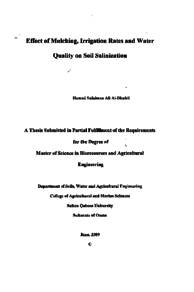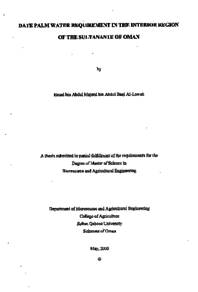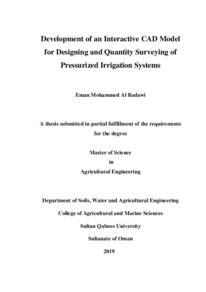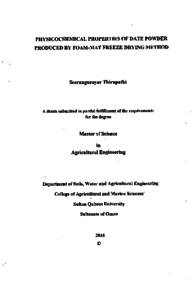وثيقة
Physiological responses and postharvest quality of banana as affected by storage conditions
الناشر
Sultan Qaboos University
ميلادي
2010
اللغة
الأنجليزية
الموضوع
الملخص الإنجليزي
Banana (Musa spp.) is one of the most important types of fruit grown and consumed in Oman and in the world. It is a significant fruit in the human diet as a source of nutrients and contributes to the reduction of oxidative stress. However, there is lack of knowledge on the postharvest technology and physiology of locally grown banana cultivars in Oman to support the development of appropriate handling and storage techniques to reduce losses and improve storage potential. The objective of this study was to determine physiological responses and to measure the changes in postharvest quality of two banana cultivars (Musa, "Malindi' and 'Milk') under three different storage conditions (refrigerator: -95.5% RH and 11 - 12 °C, room: 82 – 85% RH and 20 - 22 °C and environmental chamber; 50% RH and 18 °C for 12 hours of darkness, and 28 °C for 12 hours of light). Significant differences (p < 0.05) were observed in the fruit physicochemical properties (i.e, weight loss, firmness, color, pH, total soluble solids (TSS), titratable acidity (TA), sugar : acid ratio, and vitamin C) and physiological responses, i.e. ethylene (C2H4) and CO2 evolution in the three stages of ripening (unripe, fully-ripe and over-ripe) during those three storage conditions for each cultivar studied. The least reduction in fruit mass and highest firmness of the fruit were found using refrigerator storage compared to room and enviromental chamber. The change in peel color of each cultivar was delayed under longer refrigeration time in comparison with the other two conditions where the color changed rapidly in a shorter period of time. However, pH value was about 5 in urripe 'Malindi' and 6 in 'Milk', and generally increased or decreased during ripening. Unripe 'Milk' banana had slightly higher TSS:TA ratio but this rose rapidly during ripening of both cultivars, reaching higher value in "Malindi'. 'Milk' had significantly higher vitamin C content at all stages of ripening than 'Malindi' but 'Malindi' had higher respiration rates and ethylene production, particularly at room temperature storage. Higher weight loss of fruit in the environmental chamber than in normal room condition could be attributed to the low relative humidity and cyclic warming of fruit in the chamber. The rates of C2H4 and CO2 production were low when fruits were stored under refrigeration, leading to inhibition of ripening process and maintaining green life. The present findings confirm that refrigerated storage offered significant benefits in postharvest handling of the locally grown banana cultivars by reducing fruit weight loss (~5% loss vs 21% loss at room condition in 7 days), extending storage life (21 days vs 7 days at room condition), and enhancing vitamin C retention and concentration in fruit during ripening. Further studies are required on the development of optimal storage techniques for other cultivars including the use of controlled atmosphere storage. The regulation of fruit ripening in these banana cultivars using ethlyene inhibitiors such as 1-Methylcyclopropene (1-MCP) also warrants investigation.
المجموعة
URL المصدر
الملخص العربي
يعد الموز من أهم الفواكه المزروعة والمستهلكة محليا وعالميا كغذاء صحي مهم كما يساهم في نقص جهد الأكسدة وعلى الرغم من أهميته في الغذاء والصحة إلا أنه لا توجد معرفة جيدة حول تقنية وفيسولوجية انواع المحلية من الموز لغرض تطوير تقنيات التخزين اللازمة لتقليل كمية الخسائر وتحسين حالة التخزين للفاكهة يتلخص الغرض من هذا البحث في دراسة تاثير ثلاثة أنواع من التخزين وهي الثلاجة والغرفة والبيئة الخارجية في نوعية الخصائص الفيزوكيميائية والاستجابات الفيسولوجية على صنفين من الموز المستهلك في عمان وهي "ماليندي من مجموعة كافنديش المتقزم" و"الحليب". أثبتت الدراسات وجود إختلاف ملحوظ في الخصائص الفيزوكيميائية كالوزن والبنية واللون والرقم الهيدروجيني والمواد الصلبة الذائبة والحموضة النسبية ونسبة المواد الصلبة الذائبة إلى الحموضة النسبية وكذلك حمض الأسكوربيك (فيتامين ج)، والعوامل الفيسولوجية كالأثيلين وثاني أكسيد الكربون بين صنفي الموز بسبب حالات التخزين ومدة التخزين المحددة ومراحل النضج الثلاثة وهي مرحلة الأخضرار والنضج الكامل والشيخوخة. إذا يعتمد إتساع الأختلافات على الصنف. حيث وجد أن الصنفين لم يفقدا وزنهما بنسبة كبيرة خلال التخزين لمدة طويلة في حالة الثلاجة مقارنة بحالات الأخرى بشكل عام، بالإضافة إلى حفظ صلابة قشرة الموز لكل صنف لمدة أطول عند تلك حالة عن الحالات الأخرى. كما بقي لون القشرة لم يحدث له إي تغير لفترة أطول في حالة الثلاجة بالمقارنة مع الحالات الأخرى.
بالإضافة إلى أن قيمة الرقم الهيدروجيني كان 5 تقريبا في "الماليندي" أما في الحليب" كان 6، وانخفض بعد ذلك عموما خلال النضوج. إرتفع معدل السكر إلي الحموضة قليلا في الحليب عند مرحلة الإخضرار ولكن هذا المعدل إرتفع بسرعة خلال هذا النضج في كلا الصنفین، حيث بلغت أعلى قيمة في "الماليندي". وجد فيتامين (ج) بكثرة عالية في "الحليب" في جميع مراحل النضوج من "الماليندي" .وكان ارتفاع معدلات التنفس وإنتاج الإيثيلين في "الماليندي"، وخاصة في تخزين درجة حرارة الغرفة. ويمكن أن يكون فقدان الوزن بنسبة عالية من الفاكهة في البيئية الخارجية من الغرفة في حالة طبيعية نتيجة لانخفاض الرطوبة النسبية وارتفاع درجة حرارة من الفاكهة في البيئة الخارجية.
وأثبتت الدراسة الحالية أن عملية التخزين المبرد تفيد في الحد من فقدان وزن ثمار الفاكهة ب5% مقارنة ب 21% بالغرفة خلال 7 ايام من التخزين، وتمتد فترة التخزين إلى 21 يوم مقارنة ب7 أيام تحت ظروف الغرفة ، ويعزز الاحتفاظ بتركيز فيتامين C في الفاكهة أثناء النضج، ويلزم إجراء المزيد من الدراسات عن تطوير تقنيات التخزين اللاصناف الأخرى مثل دراسة التحكم بالغلاف الجوي. وكما يضمن التحقيق إنتظام نضج الفاكهة في أصناف الموز باستخدام مثبطات الأثيلين مثل ميثيل سيكلوبروبین تحت ظروف التخزين المطلوبة.
بالإضافة إلى أن قيمة الرقم الهيدروجيني كان 5 تقريبا في "الماليندي" أما في الحليب" كان 6، وانخفض بعد ذلك عموما خلال النضوج. إرتفع معدل السكر إلي الحموضة قليلا في الحليب عند مرحلة الإخضرار ولكن هذا المعدل إرتفع بسرعة خلال هذا النضج في كلا الصنفین، حيث بلغت أعلى قيمة في "الماليندي". وجد فيتامين (ج) بكثرة عالية في "الحليب" في جميع مراحل النضوج من "الماليندي" .وكان ارتفاع معدلات التنفس وإنتاج الإيثيلين في "الماليندي"، وخاصة في تخزين درجة حرارة الغرفة. ويمكن أن يكون فقدان الوزن بنسبة عالية من الفاكهة في البيئية الخارجية من الغرفة في حالة طبيعية نتيجة لانخفاض الرطوبة النسبية وارتفاع درجة حرارة من الفاكهة في البيئة الخارجية.
وأثبتت الدراسة الحالية أن عملية التخزين المبرد تفيد في الحد من فقدان وزن ثمار الفاكهة ب5% مقارنة ب 21% بالغرفة خلال 7 ايام من التخزين، وتمتد فترة التخزين إلى 21 يوم مقارنة ب7 أيام تحت ظروف الغرفة ، ويعزز الاحتفاظ بتركيز فيتامين C في الفاكهة أثناء النضج، ويلزم إجراء المزيد من الدراسات عن تطوير تقنيات التخزين اللاصناف الأخرى مثل دراسة التحكم بالغلاف الجوي. وكما يضمن التحقيق إنتظام نضج الفاكهة في أصناف الموز باستخدام مثبطات الأثيلين مثل ميثيل سيكلوبروبین تحت ظروف التخزين المطلوبة.
قالب العنصر
الرسائل والأطروحات الجامعية





